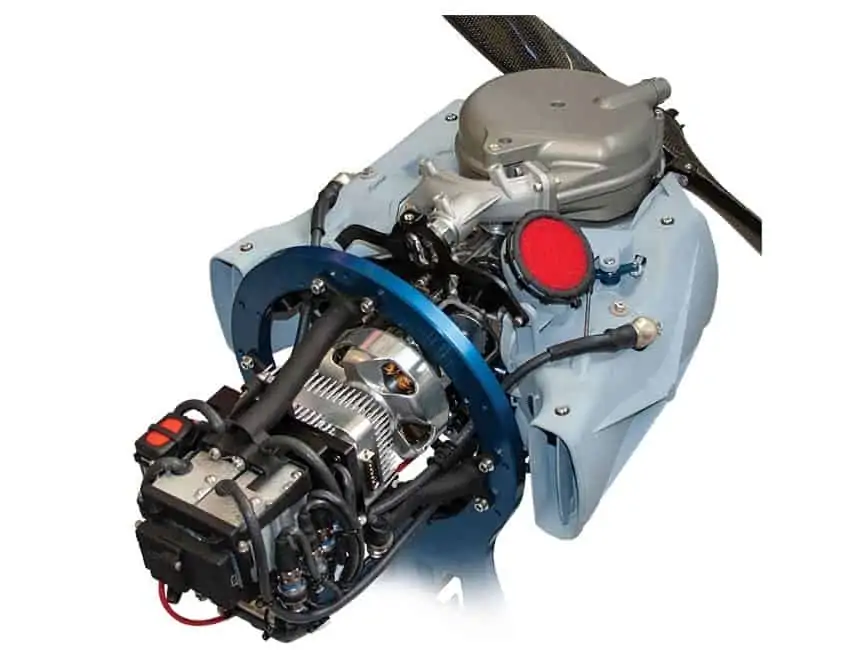
Northwest UAV has announced that its NW-88 heavy fuel twin-cylinder engine for UAVs (unmanned aerial vehicles), which in just over a year has transitioned from concept to prototype to its current extensively tested phase, is continuing to complete successful test runs. The multi-fuel NW-88 has been designed as a reliable, efficient engine for Group III UAVs.
The NW-88 heavy fuel twin-cylinder UAV engine is set to fill mission gaps in the maturing UAS industry, much like the company’s NW-44 UAV Engine has done before it. The aviation grade NW-88 engine is designed to offer endurance and reliability gains to Group III UAVs in the 75-150 pound weight class, which are increasingly being used for commercial and military purposes.
“We noticed as the popularity of the NW-44 engine grew, that Group III UAVs in the 75-150-pound weight class were experiencing the same endurance and reliability issues that the NW-44 engine addressed in Group II UAVs,” Chris Harris, President and Owner of Northwest UAV said. “OEMs and end users (the OEM’s customers) are hungry for an aviation grade option, which is to say that they are looking for a higher level of maturity, maintainability, reliability, and consistency in their propulsion system. We’ve taken what we’ve learned from developing aviation grade qualities in the NW-44 engine and applied those technologies to the NW-88. In fact, many of the components on the NW-88 are shared with the NW-44. Utilizing proven components greatly reduced the NW-88 development timeline as well as cost and has resulted in superior test results. In addition, these shared components are cost effective for customers deploying both the NW-44 and the NW-88, which were designed for easy maintenance and overhaul.”
As NWUAV continues to test the NW-88 heavy fuel engine in their test facilities, market interest in the engine continues to grow. “We are really pleased with the performance of the NW-88 and are seeing impressive BSFC and HP numbers as it relates to the displacement and overall size and weight of the engine”, said Chris Harris. “When OEM’s select an engine solution they consider many things, but one critical factor that typically gets ignored or overlooked while reviewing performance data is the size of the engine and the associated parasitic drag that will be induced into the airframe, which can have a dramatic effect on endurance. When developing engine systems, we focus heavily on packaging and reducing the overall footprint by incorporating technology such as our patented conformal muffler designed for best BSFC at cruise. We have been asked many times about the potential of efficiency gains with direct injection. We have purposefully stayed away from that approach due to the additional parasitic drag that is induced with the increased cylinder height and the limited time for an injection event on small displacement 2 stroke engines. On a 4-stroke engine there is roughly 270 degrees of crank rotation to inject the required amount of fuel. On a smaller 2-stroke engine there is about 30 degrees of crank rotation after the transfer and exhaust ports are covered by the approaching piston. This leaves about 2 ms to inject fuel, or ~½” of piston movement, before the spark event. To expect a consistent homogeneous fuel mixture prior to the spark event seems unrealistic.”
The NW-88 boxer twin has a unique injection strategy that utilizes twin throttle bodies, injectors and dual rotary valve intakes. This engine core design addresses an industry-wide issue with boxer twins, where both cylinders share the lower end volume leading to variable fuel mixtures at different throttle settings and altitudes. NWUAV’s strategy permits a matched homogeneous fuel mixture between cylinders, which ensures the heavy fuel is well-vaporized prior to entering the cylinder. This leads to impressive BSFC numbers throughout the RPM range.
“The NW-88 engine is a commercial off-the-shelf (COTS) aviation grade engine just like the NW-44,” Harris explained, “A COTS engine solution saves OEMs a substantial amount of time and money. Rather than trying to develop and mature their own engine system, a process that takes years, Northwest UAV does the work for the OEM. We understand the full progression from the ground up, including the cost and infrastructure required to mature initial engine development systems into qualified tested production products.”


















